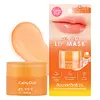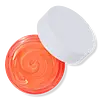What's inside
What's inside
 Key Ingredients
Key Ingredients

 Benefits
Benefits

 Concerns
Concerns

 Ingredients Side-by-side
Ingredients Side-by-side

Hydrogenated Polyisobutene
EmollientSqualane
EmollientPetrolatum
EmollientMicrocrystalline Wax
Emulsion StabilisingPolyisobutene
Hydrogenated Styrene/Isoprene Copolymer
Ascorbyl Tetraisopalmitate
AntioxidantSynthetic Wax
AbrasiveAroma
Tridecyl Trimellitate
EmollientHydroxystearic Acid
CleansingMenthone Glycerin Acetal
RefreshingArgania Spinosa Kernel Oil
EmollientLimnanthes Alba Seed Oil
Skin ConditioningTocopheryl Acetate
AntioxidantOlea Europaea Fruit Oil
MaskingCitrus Aurantium Dulcis Peel Oil
MaskingCitrus Tangerina Peel Oil
MaskingPentaerythrityl Tetra-Di-T-Butyl Hydroxyhydrocinnamate
AntioxidantCeramide NP
Skin ConditioningTocopherol
AntioxidantBHT
AntioxidantCI 19140
Cosmetic ColorantCI 77891
Cosmetic ColorantCI 15850
Cosmetic ColorantHydrogenated Polyisobutene, Squalane, Petrolatum, Microcrystalline Wax, Polyisobutene, Hydrogenated Styrene/Isoprene Copolymer, Ascorbyl Tetraisopalmitate, Synthetic Wax, Aroma, Tridecyl Trimellitate, Hydroxystearic Acid, Menthone Glycerin Acetal, Argania Spinosa Kernel Oil, Limnanthes Alba Seed Oil, Tocopheryl Acetate, Olea Europaea Fruit Oil, Citrus Aurantium Dulcis Peel Oil, Citrus Tangerina Peel Oil, Pentaerythrityl Tetra-Di-T-Butyl Hydroxyhydrocinnamate, Ceramide NP, Tocopherol, BHT, CI 19140, CI 77891, CI 15850
Polybutene
Octyldodecanol
EmollientTrimethylolpropane Triisostearate
EmollientMicrocrystalline Wax
Emulsion StabilisingHydrogenated Poly(C6-14 Olefin)
EmollientHydrogenated Styrene/Isoprene Copolymer
Stearalkonium Hectorite
Gel FormingArgania Spinosa Kernel Oil
EmollientOlea Europaea Fruit Oil
MaskingRosa Canina Fruit Oil
EmollientRubus Idaeus Seed Oil
EmollientRubus Idaeus Leaf Extract
Skin ConditioningAroma
Dicalcium Phosphate
AbrasiveGlycerin
HumectantPropylene Carbonate
SolventCaprylic/Capric Triglyceride
MaskingPerlite
AbsorbentTocopherol
AntioxidantLimonene
PerfumingSodium Saccharin
MaskingPentaerythrityl Tetra-Di-T-Butyl Hydroxyhydrocinnamate
AntioxidantBenzyl Alcohol
PerfumingBenzyl Benzoate
AntimicrobialCI 77891
Cosmetic ColorantCI 15985
Cosmetic ColorantCI 15850
Cosmetic ColorantPolybutene, Octyldodecanol, Trimethylolpropane Triisostearate, Microcrystalline Wax, Hydrogenated Poly(C6-14 Olefin), Hydrogenated Styrene/Isoprene Copolymer, Stearalkonium Hectorite, Argania Spinosa Kernel Oil, Olea Europaea Fruit Oil, Rosa Canina Fruit Oil, Rubus Idaeus Seed Oil, Rubus Idaeus Leaf Extract, Aroma, Dicalcium Phosphate, Glycerin, Propylene Carbonate, Caprylic/Capric Triglyceride, Perlite, Tocopherol, Limonene, Sodium Saccharin, Pentaerythrityl Tetra-Di-T-Butyl Hydroxyhydrocinnamate, Benzyl Alcohol, Benzyl Benzoate, CI 77891, CI 15985, CI 15850
 Reviews
Reviews

Ingredients Explained
These ingredients are found in both products.
Ingredients higher up in an ingredient list are typically present in a larger amount.
You may know this ingredient as argan oil. Argan Oil has antioxidant, hydrating, and soothing properties.
Studies have shown argan oil can help fight again radical damage from the sun. This makes it effective at preventing hyperpigmentation.
Large amounts of vitamin E found in argan oil helps the skin retain water. Argan oil also contains fatty acids such as linoleic acid, oleic acid, and palmitic acid. It is also a good source of lipids.
Another benefit of argan oil is skin-soothing. It can help reduce inflammation-related skin symptoms.
Argan Oil is effective at regulating sebum production in pores. This can make it effective at treating hormonal acne.
Traditionally, argan oil was used for its antibacterial and antifungal properties. However, argan oil contains fatty acids that may make it not fungal-acne safe.
Argan Trees are native to Morocco.
Learn more about Argania Spinosa Kernel OilAroma refers to an ingredient, or mixture of ingredients, that impart or mask a flavor.
The name is slightly confusing. This is because INCI associates aroma with flavor instead of smell.
Here is the official definition from the The International Cosmetic Ingredient Dictionary and Handbook:
“Aroma is a term for ingredient labeling used to identify that a product contains a material or combination of materials normally added to a cosmetic to produce or to mask a particular flavor.”
INCI shows the only purpose of aroma to be "flavouring".
However, due to regulation differences, some companies may use aroma in place of parfum.
In Canada, this ingredient only has to be listed in concentrations above 1%.
Learn more about AromaCi 15850 is the pigment color red. It is an azo dye and created synthetically.
Azo dyes need to be thoroughly purified before use. This allows them to be more stable and longer-lasting.
This ingredient is common in foundations, lipsticks, and blushes. This color is described as brown/orangey red.
It has many secondary names such as Red 6 and Red 7. According to a manufacturer, Red 6 usually contains aluminum.
Learn more about CI 15850Ci 77891 is a white pigment from Titanium dioxide. It is naturally found in minerals such as rutile and ilmenite.
It's main function is to add a white color to cosmetics. It can also be mixed with other colors to create different shades.
Ci 77891 is commonly found in sunscreens due to its ability to block UV rays.
Learn more about CI 77891We don't have a description for Hydrogenated Styrene/Isoprene Copolymer yet.
Microcrystalline Wax is created by de-oiling petroleum. It is highly refined and purified before being added to cosmetics.
Microcrystalline Wax is used to enhance the texture and create even consistency. It helps stabilize a product by preventing ingredients from separating.
Olea Europaea Fruit Oil is the fixed oil obtained from the ripe fruit of the Olive. In other words - olive oil.
The primary contents of olive oil are glycerides of the fatty acids linoleic, oleic and palmitic.
Olive oil also contains antioxidants such as Vitamin E. Antioxidants may help reduce signs of aging by fighting unstable free-radical molecules. It also contains Vitamins A (retinol), D, and K.
The squalene in olive oil makes it a great emollient. Emollients help soothe and soften your skin by trapping moisture in. This makes olive oil a great skin moisturizer.
Studies show olive oil to have antibacterial and antifungal properties in low concentrations. Another study found olive oil irritated sensitive oily skin. We always recommend speaking with a professional about using this ingredient in your routine.
Due to the fatty acid content, this ingredient may not be fungal-acne safe.
Learn more about Olea Europaea Fruit OilPentaerythrityl Tetra-Di-T-Butyl Hydroxyhydrocinnamate (long name, huh?) is a synthetic antioxidant.
It is used to help stabilize other antioxidants or prevent the color from changing in a product.
As an antioxidant, it helps fight free-radical molecules. Free-radical molecules are capable of damaging our cells and other genetic material. Thus, antioxidants may reduce the signs of aging.
This ingredient is oil-soluble.
Learn more about Pentaerythrityl Tetra-Di-T-Butyl HydroxyhydrocinnamateTocopherol (also known as Vitamin E) is a common antioxidant used to help protect the skin from free-radicals and strengthen the skin barrier. It's also fat soluble - this means our skin is great at absorbing it.
Vitamin E also helps keep your natural skin lipids healthy. Your lipid skin barrier naturally consists of lipids, ceramides, and fatty acids. Vitamin E offers extra protection for your skin’s lipid barrier, keeping your skin healthy and nourished.
Another benefit is a bit of UV protection. Vitamin E helps reduce the damage caused by UVB rays. (It should not replace your sunscreen). Combining it with Vitamin C can decrease sunburned cells and hyperpigmentation after UV exposure.
You might have noticed Vitamin E + C often paired together. This is because it is great at stabilizing Vitamin C. Using the two together helps increase the effectiveness of both ingredients.
There are often claims that Vitamin E can reduce/prevent scarring, but these claims haven't been confirmed by scientific research.
Learn more about Tocopherol